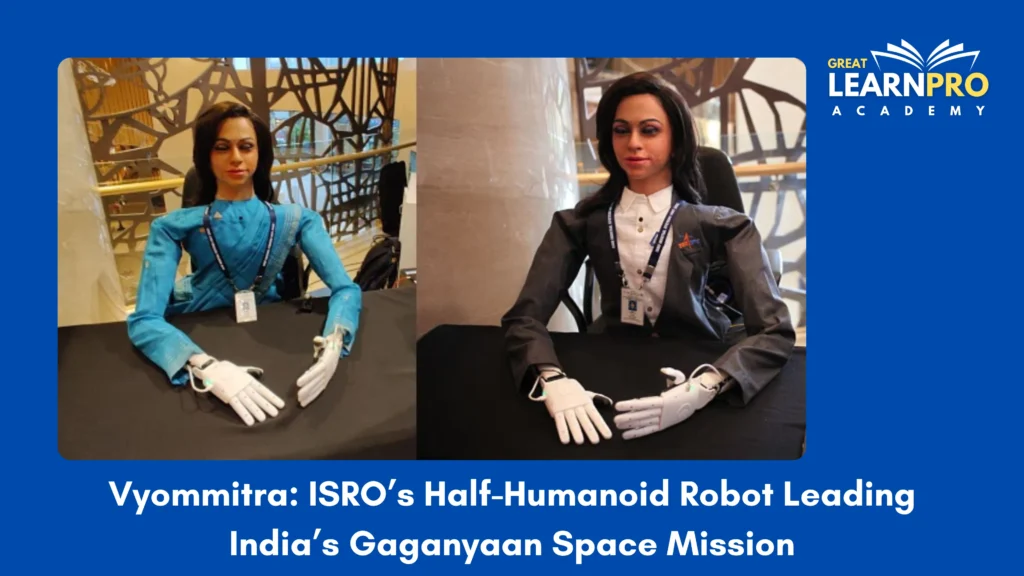“Vyommitra” is a name derived from two Sanskrit words: Vyoma, meaning “space,” and Mitra, meaning “friend.” Together, it means “friend in space.” Vyommitra is India’s first humanoid robot developed by the Indian Space Research Organisation (ISRO). It is a half-humanoid, meaning it has a head, torso, and arms but no legs. Designed to perform human-like functions in space environments, Vyommitra will play a crucial role in ISRO’s ambitious Gaganyaan human spaceflight mission.
Vyommitra was first unveiled in January 2020 during the “Human Spaceflight and Exploration — Present Challenges and Future Trends” event held in Bengaluru. This marked a historic moment, positioning India among the few countries that have created humanoid robots for space exploration.

Design and Development
The humanoid was conceptualized and developed by the ISRO Inertial Systems Unit (IISU) in Thiruvananthapuram. The IISU was responsible for its design, integration, and programming, while the Vikram Sarabhai Space Centre (VSSC) contributed to specific components such as finger design and motion mechanisms. Vyommitra’s structure is limited to its upper body since its operations will primarily take place inside the spacecraft cabin rather than on the surface of any celestial body.
The project showcases ISRO’s commitment to indigenous innovation and its ability to integrate multiple scientific disciplines such as robotics, artificial intelligence, avionics, and materials science. The humanoid’s creation also reflects the organization’s intent to bridge the gap between automated missions and manned missions.
Features and Capabilities
Vyommitra is designed to perform a variety of tasks that mimic those of a human astronaut. Some of its notable features include:
- Speech and Voice Recognition: Vyommitra can recognize human voices, respond to spoken commands, and engage in two-way communication with astronauts and mission control.
- Facial and Visual Recognition: Equipped with cameras and sensors, it can identify human faces, respond with expressions, and perform visual monitoring inside the spacecraft.
- Control Panel Operations: The humanoid can operate control panels, toggle switches, read displays, and monitor onboard systems such as cabin temperature, air pressure, oxygen levels, and humidity.
- Communication with Ground Control: Vyommitra is capable of reporting mission data, status updates, and anomalies to ground control through automated communication systems.
- Flexibility and Dexterity: While it lacks legs, Vyommitra can bend forward, move sideways, rotate its arms, and handle tools or instruments as needed.
The humanoid’s frame is made from lightweight alloys and composite materials that can endure high stress, vibrations, and the physical forces experienced during launch and orbit operations.
Role in the Gaganyaan Mission
Vyommitra will play a pioneering role in ISRO’s Gaganyaan mission, India’s first manned space programme. Before sending astronauts, ISRO plans to conduct two uncrewed test flights. Vyommitra will be onboard these missions to simulate the physiological and operational responses of human presence in space.
Its purpose is to monitor the spacecraft’s environmental systems, test life-support mechanisms, and ensure all conditions are safe for human travel. It will serve as a “robotic crew member,” operating control panels and relaying real-time data to mission control.
The first uncrewed Gaganyaan mission (G1) featuring Vyommitra is scheduled for December 2025. Another uncrewed mission is expected to follow in 2026. If both succeed, India aims to conduct its first crewed Gaganyaan mission by early 2027.
Significance and Impact
The development of Vyommitra has deep technological and symbolic significance for India’s space programme.
- Risk Reduction: By testing systems through Vyommitra, ISRO ensures that safety measures are verified before human astronauts are exposed to the risks of spaceflight.
- Technological Advancement: The project integrates robotics, artificial intelligence, avionics, and human–machine interaction, enhancing India’s overall technological ecosystem.
- Global Recognition: With Vyommitra, India joins an elite group of spacefaring nations such as the United States, Russia, Japan, and China, which have successfully developed humanoid robots for space missions.
- Future Space Applications: The research behind Vyommitra will serve as a foundation for future robotic assistants on lunar or planetary bases, long-duration missions, and deep-space explorations.
- Inspiration for Young Scientists: Vyommitra symbolizes India’s scientific vision and has inspired young minds to pursue careers in robotics, AI, and aerospace engineering.
Recent Developments
ISRO has recently confirmed that Vyommitra’s uncrewed test flight will take place in December 2025. A digital twin of Vyommitra a virtual replica of the humanoid—is being developed to test and simulate its performance under space conditions. This allows scientists to identify and resolve potential technical issues before the actual launch.
Additionally, ISRO engineers are enhancing Vyommitra’s voice recognition, sensory perception, and control panel response speed to make it more interactive and efficient during flight operations.
Conclusion
Vyommitra is more than just a robot it is a symbol of India’s technological evolution and scientific ambition. It bridges the gap between automated missions and human spaceflight, serving as a crucial step toward ensuring astronaut safety and mission reliability.
As India prepares to send humans into space, Vyommitra will act as the nation’s first representative in orbit—a friendly companion and test subject paving the way for future generations of astronauts. The humanoid represents not only technological innovation but also India’s growing confidence in taking on complex, high-stakes missions in space exploration.
In essence, Vyommitra is India’s “space friend” a blend of science, ingenuity, and national pride, ready to make history aboard the Gaganyaan mission.
References
- https://www.business-standard.com/india-news/who-is-vyommitra-the-female-robot-isro-is-sending-on-gaganyaan-mission-123082900969_1.html
- https://indianexpress.com/article/cities/bangalore/meet-vyomamitra-the-robot-isro-is-sending-to-space-6230242/
- https://www.indiatoday.in/science/story/gaganyaan-vyommitra-talking-humanoid-isro-space-1639077-2020-01-22
- https://www.thehindu.com/sci-tech/science/vyommitra-isros-humanoid-for-unmanned-missions-gets-computer-brain/article65975585.ece
- https://timesofindia.indiatimes.com/science/isro-gaganyaan-2025-indias-first-uncrewed-g1-mission-with-vyommitra-set-to-launch-in-december/articleshow/123450124.cms
- https://www.firstpost.com/explainers/what-we-know-about-vyommitra-the-female-humanoid-that-isro-is-sending-on-the-gaganyaan-mission-13047402.html
More Current affairs: https://learnproacademy.in/updates/
